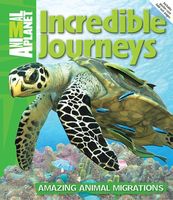 Title: Incedible Journeys Amazing Animal Migrations
Title: Incedible Journeys Amazing Animal Migrations
Author(s): Dwight Holing
Release year: 2011
Publisher: Weeldon Owen
Why in Database: Book about animals migration. The turtles first appear in a series of minor mentions, and then there are two whole pages devoted to them, with a lot of passages on those two pages. There are also pictures here and there.
Incredible Journeys is filled with such stories. Meet a bird that flies from pole to pole and back again – a yearly trip of nearly 80,000 kilometres. Follow a sea turtle hatchling, so small it would fit in your hand, as it cracks out of its egg, scrambles across a beach and catches a current that carries it across the ocean.
Conveyor belt
Turtles use Atlantic Ocean currents to carry them smoothly between far-flung feeding and nesting sites.
Jellyfish, eels and sea turtles undertake incredible journeys, too.
Ocean currents sucha s the Gulf Stream give travellers like sea turtles a lift on long migrations.
Long Lives
Sea turtles live for up to 50 years and migrate across the world’s great oceans.
All of the following fragments are from the two mentioned turtle-filled pages:
Leatherback turtle fact file
Type Sea turtle
Family Dermochelyidae
Scientific name Dermochelys coriacea
Diet Jellyfish
Average lifespan 45 years
Size Up to 2m
Weight Up to 700kg
Race winners Large flippers and a streamlined body make leatherbacks the fastest swimming sea turtle.
Riding the current
Among the oldest of all creatures, sea turtles evolved over 110 million years ago. Seven species still exist, but all are at risk of extinction. Fishing and building on beaches are part of the reason why. Sea turtles spend nearly all of their time in the water, coming ashore only briefly to lay their eggs. Catching ocean currents helps them when migrating. Some species, like the leatherback, travel across entire oceans.
Leatherback
Leatherbacks are the largest of all sea turtles and are unlike most others. Their shell is not bony but instead, is made of skin and oily flesh. Their flippers are the biggest in proportion to their overall size. The front pair can grow as long as 2.7 metres. Leatherbacks have the widest global distribution, too. They range from Norway to the tip of New Zealand. They are also the deepest divers, able to go 1,280 metres below the surface.
Cold waters An extra layer of fat helps leatherbacks keep from freezing in cold water like that of Alaska
Migration
Leatherbacks travel from cold water, where they feed, to warm-climate beaches, where they hatch. Journeys average 6,000 kilometres. One sea turtle was tracked from its nesting site in Indonesia to California – a 20,000-kilometre trip.
Global Leatherbacks roam the oceans widely, including to the waters off the Cape of Good Hope, South Africa (right).
Nesting and laying
Most sea turtle species return to lay their eggs on the same beach where they hatched years before. The female crawls to a dry part of the beach after mating and uses her front flippers to dig a shallow pit the size of her body. Then she shovels out an egg cavity using her cupped rear flippers and lays 80-120 eggs. She covers the eggs with sand when she has finished and heads back to the sea.
Hatchlings
It takes a little over a month for the eggs to hatch. The temperature beneath the sand determines which sex the hatchlings will be Temperatures warmer than 29.5°C produce females. Cooler temperatures produce males. Once the baby sea turtles break out of their shells, they waste no time heading for the safety of the water.
Sand tracks Gently sloping beaches make getting in and out of the water easier.
Darkness Turtles nest at night to help hide the eggs from predators like gulls.
Hatchlings
It takes a little over a month for the eggs to hatch. The temperature beneath the sand determines which sex the hatchlings will be. Temperatures warmer than 29.5°C produce females. Cooler temperatures produce males. Once the baby sea turtles break out of their shells, they waste no time heading for the safety of the water.
Mad dash Hatchlings must cross the beach quickly to avoid predators.




Author: XYuriTT
